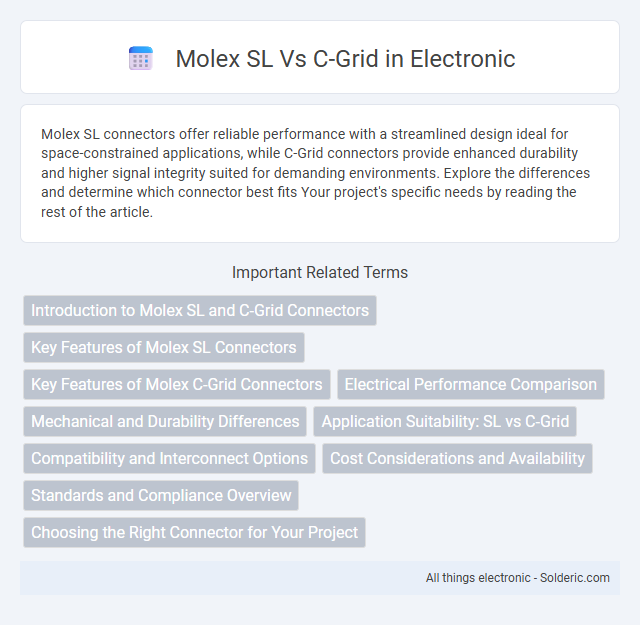Molex SL connectors offer reliable performance with a streamlined design ideal for space-constrained applications, while C-Grid connectors provide enhanced durability and higher signal integrity suited for demanding environments. Explore the differences and determine which connector best fits Your project's specific needs by reading the rest of the article.
Comparison Table
| Feature | Molex SL | C-Grid |
|---|---|---|
| Connector Type | Surface Mount | Grid Array |
| Contact Pitch | 1.27 mm typical | 0.5 mm typical |
| Contact Count | Up to 100 contacts | Up to 400 contacts |
| Application | General Board-to-Board | High-Density Board-to-Board |
| Mounting Style | Surface Mount Technology (SMT) | Surface Mount & Through Hole |
| Current Rating | Up to 1.5A per contact | Up to 0.5A per contact |
| Operating Temperature | -40degC to +105degC | -55degC to +125degC |
| Typical Use | Consumer Electronics, Industrial | Mobile Devices, Telecom Equipment |
| Durability | Up to 30 mating cycles | Up to 50 mating cycles |
Introduction to Molex SL and C-Grid Connectors
Molex SL connectors are designed for high-density, reliable power and signal interconnections, offering low-profile contact designs ideal for compact electronic devices. C-Grid connectors deliver enhanced signal integrity with a modular, grid-based contact layout, supporting high-speed data transmission in complex systems. Both connector types cater to advanced electronic applications requiring durability, precise alignment, and optimized electrical performance.
Key Features of Molex SL Connectors
Molex SL connectors feature a slim, low-profile design optimized for space-constrained applications, ensuring reliable signal integrity and ease of mating. These connectors support high-speed data transmission with robust locking mechanisms that prevent accidental disconnection during operation. Your projects benefit from the Molex SL's versatile configuration options and durable materials, enhancing performance in demanding electronic environments.
Key Features of Molex C-Grid Connectors
Molex C-Grid connectors offer a unique grid array contact design that enhances signal integrity and supports high-density interconnect applications. They feature robust metal shells for EMI shielding and come in various pitch sizes, ensuring versatility for diverse electronic systems. Your projects benefit from reliable low insertion force contacts that improve connection stability and longevity.
Electrical Performance Comparison
Molex SL connectors provide superior electrical performance with lower contact resistance and enhanced signal integrity compared to C-Grid connectors, making them ideal for high-speed data transmission. The SL series supports higher current ratings and exhibits improved crosstalk reduction due to its optimized contact design and advanced plating materials. These features result in more reliable connections in high-frequency applications where consistent electrical performance is crucial.
Mechanical and Durability Differences
Molex SL connectors feature a robust terminal design with enhanced strain relief, providing superior mechanical stability compared to the C-Grid series. The C-Grid connectors emphasize compactness but offer less resistance to mechanical stress and vibration, impacting long-term durability. Molex SL's reinforced contact retention and rugged housing materials deliver extended lifecycle performance ideal for demanding industrial applications.
Application Suitability: SL vs C-Grid
Molex SL connectors are ideal for compact, high-density electronic assemblies, offering reliable signal integrity in tight spaces, whereas the C-Grid series excels in robust applications requiring enhanced durability and higher current-carrying capacity. SL connectors suit consumer electronics and small-scale industrial devices, while C-Grid connectors are preferred in automotive, heavy machinery, and aerospace sectors where vibration resistance and ruggedness are critical. The choice between SL and C-Grid depends on specific requirements for space constraints, current ratings, and environmental exposure in the targeted application.
Compatibility and Interconnect Options
Molex SL connectors offer versatile compatibility with a wide range of PCB layouts and support various wire-to-board and wire-to-wire interconnect configurations. In contrast, Molex C-Grid connectors specialize in high-density applications, providing robust signal integrity with a compact footprint and multiple pitch options for flexible system integration. Both series deliver reliable electrical performance and mechanical stability across diverse industrial and commercial environments.
Cost Considerations and Availability
Molex SL connectors typically offer a lower upfront cost compared to C-Grid systems due to simpler manufacturing processes and widespread production. C-Grid connectors, while generally more expensive, provide enhanced performance and reliability, which can justify the higher investment in long-term applications. Availability for Molex SL is robust with extensive distribution channels, whereas C-Grid connectors may experience limited stock depending on supplier and region.
Standards and Compliance Overview
Molex SL connectors adhere to stringent industry standards including IEC 61076-4-107 and UL certifications, ensuring high reliability and safety in industrial automation applications. In contrast, Molex C-Grid connectors comply with IEC 61076-4-101 standard, emphasizing compact design and high-density configurations for space-constrained environments. Both series meet RoHS and REACH compliance, supporting environmental sustainability requirements in electronic component manufacturing.
Choosing the Right Connector for Your Project
Choosing the right connector between Molex SL and C-Grid depends on your project's requirements for size, pin density, and application environment. Molex SL connectors offer compact design and high-reliability performance ideal for space-constrained electronics, while C-Grid connectors provide robust stacking and high-current capacity suited for complex signal and power applications. Evaluating factors like mechanical durability, mating cycles, and electrical specifications ensures optimal connector selection for seamless integration and long-term functionality.
Molex SL vs C-Grid Infographic

 solderic.com
solderic.com